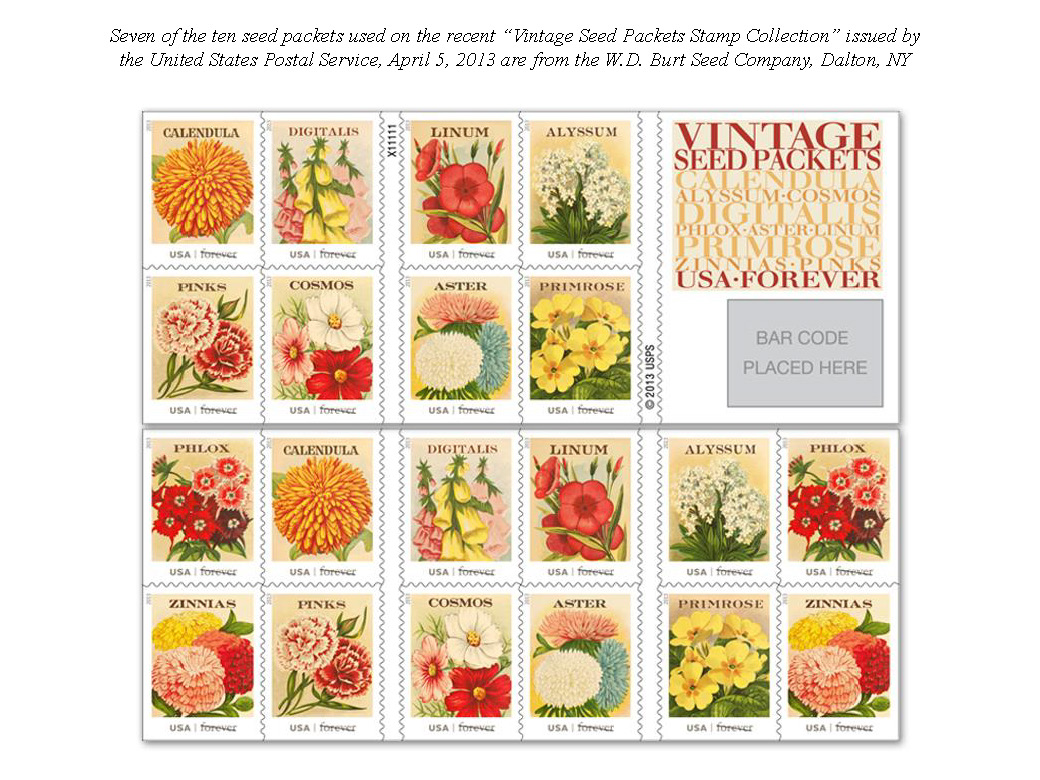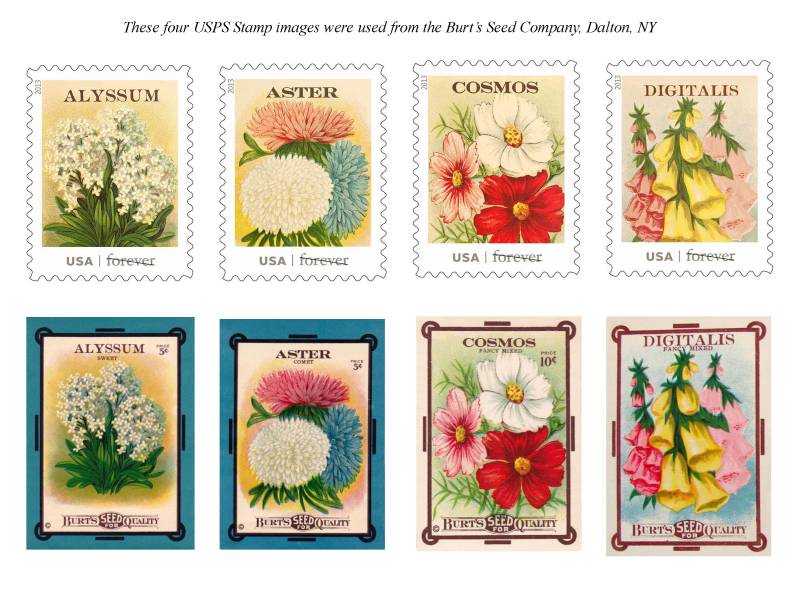
 |
The History of
the W.D. Burt Seed Companies 1894 – 1944 by: Delene Burt, Richard E. Burt, and Thomas Burt
William
D. Burt, better known as W.D., to his family and
friends was an enterprising teenager in the early
1890’s. His
father, George owned a hotel call the Parker House,
located in the small hamlet of In
the early 1890’s gardening and gardeners were
oddities. So
when W.D. began to till the muck soil in the back of
the Parker House Hotel to grow his giant pumpkin, he
found himself the object of everyone’s jokes. But in the
end, the joke was on the jokesters, as he won the
prize. W.D.
was inquisitive and did a great deal of research
before he sent for his pumpkin seeds from the
Philadelphia Company.
The best authorities of the day said that to
raise a giant pumpkin one needed to fertilize with hog
manure. While
other experts advised to submerse the pumpkin tendrils
in milk. W.D.
wasn’t taking any chances and he experimented using
both techniques.
The
prize pumpkin was planted in rich soil and as the buds
formed he clipped off all except one. This meant
he would only grow one pumpkin on the vine, but the
tendrils of this one pumpkin were submersed in a saucer
of milk daily.
Soon the town’s people were no longer calling
W.D. “Punkin” and people would stop by daily to watch
his pumpkin grow.
It was said you could stand there and actually
see it grow. Of
course the pumpkin won the prize. It was
proudly placed on display at the Parker House Hotel
for all to admire.
Eventually
his seed packets came to the attention of the 5 and 10
cents stores, namely: S.S. Kresge, F.W. Woolworth and
S.H. Kress. It
was the 5 and 10 cent stores orders, along
with the Sears Roebuck orders that finally put W.D. Burt
and Burt Seed Company on the over-night road to
success. The
demand for seed packets from these companies
made it possible for W.D. to
purchase seeds from
Although
the seed business closed its doors in the “40s the
building that housed the seed business still remains. The
dark brown wooden edifice is a reminder of another
time, when life was a little simpler and townspeople
worked where they lived.
The Burt Seed Company was one man’s dream, but
a whole town’s accomplishment. Evidence of
one of W.D.’s cultivated gardens still remains. Two
blocks away from where the old warehouse stands,
is a peony patch that blooms each spring and
carries its wonderful sweet scents wafting on the
breeze and into the homes of its nearby neighbors. W.D.’s
peonies live on in the yards of many
    Growing up, my grandfather, Malcolm always told us the story of W.D. and how he started the seed company by growing a massive pumpkin in the dooryard of his father's hotel (the Parker House). While completing some research several years ago, I came across a reference to this article and my nephew was finally able to find a microfilmed copy at a university in the Southwest. Below is a copy of that article published in the March 22, 1919 edition of the Forbes Magazine, about W.D. Burt, the early history and the "Great Pumpkin Story" BUILDS
FORTUNE FROM PUMPKIN SEED
Forbes Magazine Mar 22, 1919 Fact-Story that outclasses the pumpkin that changed into royal coach 
No lad ever wanted to go to college harder than I did when I was handed a high school diploma back in the ‘90s. Two things denied me this privilege – lack of wealth, poor health. The future looked mighty gloomy for me one day, by the merest chance, my attention was directed to an advertisement that was destined to make me glad that I never went to an academic institution. A big seed company in Philadelphia was offering a prize for growing the biggest pumpkin. At first the idea of entering this contest was very amusing, and as a joke I sent for the pumpkin seeds. Incipient tuberculosis dictated an outdoor life for me, and I naturally turned to gardening – pumpkin gardening at that. It was too good a joke to be kept quiet; for miles around fun was poked at me from every source by the amused countryside, I was nicknamed “Punkin.” You see I lived right in town where everybody could easily see what I was doing as they passed by. My father was the owner of a small hotel, and the only place where I could raise my pumpkins was in the adjoining yard.
Few Gardeners Then
No one would take a second look at a dooryard garden. Nowadays we have grown accustomed to the idea from seeing many War Gardens; but that was not the case a quarter of a century ago. When my pumpkin seeds were well germinated and the vines started, the wonder and amusement grew. To begin with, the ground had been spaded up carefully and all well fertilized with hog manure. I had become earnestly interested and the best authorities that I could find on the subject maintained that there was but one way to enrich the soil to suit the taste of a hungry pumpkin vine, to use hog fertilizer. As soon as the vines were well started the healthiest one was selected for my experiment. It is a well-known fact that wherever the pumpkin vine carries a group of leaves, just underneath will be found a cluster of tiny tendrils. These tendrils extend down into the ground and furnish nourishment, as do the original roots. Where the first set of tendrils started to grow, I scooped away the soil and placed a pan of milk. A little beyond the tendrils I cut the vine off. Eventually the vine blossomed and I was careful to allow only one pumpkin set to form. In two weeks, I had a well-shaped green pumpkin growing on my vine between the roots and the tendrils. On one side that fortunate pumpkin was fed up on rich hog fertilized soil, while on the other it was nourished with milk. Some people will tell you today that you could actually see that pumpkin grow. Any-how it expanded rapidly. As its size became enormous compared with any pumpkin that anybody had seen, people quit laughing at my enterprise and their fun turned to wonder. Hundreds of people came to see this big “punkin,” and so its fame spread far. Many people wrote me asking how I had managed to grow such a big specimen, and later when harvest time came wanted to buy seeds from it. Of course, my pumpkin won the prize. Up to this time I had never thought of going into the seed business. In fact, I knew absolutely nothing whatever about it. The offers to buy seed suggested that I might do a good business in selling the contents of my prize pumpkin. Every last seed was disposed of at a cent apiece. This was my start in the seed world. From Pumpkins to other Vegetables
Next season I grew more mammoth pumpkins, all the time getting more and more interested in in raising garden produce for the value of the seeds. By the third year I had added several different kinds of vegetables to my list and was experimenting with different methods of preserving the seeds. Several years I did a fairly good local business. More and more people heard of my famous pumpkins, and I began to get orders from all over the country asking for that particular kind of seeds. The mail order business, however was not sufficient, and I depended upon a house to house peddling to swell the results. Year after year I cultivated my garden, saved the seeds, and then spent the late fall and early winter canvassing the country for many miles around. The farmers and townspeople gradually came to depend on me for garden seeds. Eventually I tried the commission box trade. My gardens were enlarged and I employed several men to help in taking care of them. The seeds were placed in ordinary paper sacks, marked with a pencil and placed in rough basswood boxes for display. These commission boxes were distributed in all the stores where I could get the proprietors interested, and later I collected the boxes and the money for seeds sold. In early spring each box was filled again and displayed in some store. Enters Mail Order Field
Commission box business was not a success the way I conducted it and the fact was evident that I must find some other market for my seeds. I invested what looked then like a young fortune $10, in a single advertisement which ran in a national farm magazine. That was the way I broke into the mail order business, and of course it was a great help to be able to feature the mammoth pumpkin in this advertising campaign. That was a good many years ago. They still write me from all over the world for those big pumpkin seeds. The original pumpkin garden has increased in size until it covers many acres and its vines actually grow around the globe. Naturally, pumpkin seeds do not comprise the great bulk of my business today, but just the same those first pumpkin seeds were the foundation. All Rights Reserved 2015-2022
Thomas Burt No reproductions without prior permission |